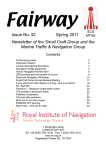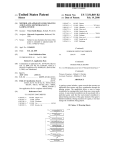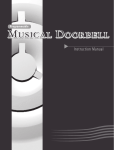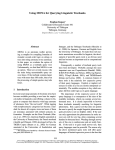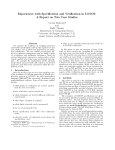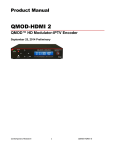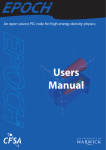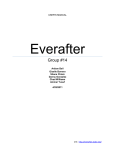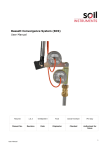Download Description Description Textual Description Textual
Transcript
Description
Description
• Quite often, we describe things by way of analytic models, for
example :– Data flow diagrams
– Entity relationship diagrams
– Decision tables
– Finite State Machines
– Class diagrams
– etc.
Where appropriate, use them.
• However, all these models incorporate text and, often, we use
text (Natural Language, Plain English) alone . .
and, with good reason !
• A large part of RE is description
• In particular, we must describe:– the characteristics of the problem domain
– the behaviour of the solution system
© I K Bray, 2004
1
© I K Bray, 2004
Textual Description
2
Textual Description
The bad news :– Good documentation requires very good writing
– Producing very good writing is difficult
– At the least, it requires years of practice
– To be blunt, some people will never get there
The good news :– But all can improve (!) and
– As we shall see, we have some guidelines (largely from
Jackson identifies 2 ways of defining terms :• Designation
– the informal definition of fundamental terms
• (Formal) Definition
– the more or less formal definition of derived terms (in terms of
designated terms)
And (using defined terms) we can produce 2 sorts of description:• Rough sketch
[KOVITZ99])
– an informal description (generally, “work in progress”)
• Refutable description
– a description that is, in principle, testable
© I K Bray, 2004
3
© I K Bray, 2004
Designation
Designation
• The foundations for all other descriptions
• Takes the form of a recognition rule, e.g. -
When and what do we designate?
• When precision is important (pretty much always in RE !)
• We designate all fundamental specialist terms and concepts (that
cannot be formally defined)
• In particular we must designate data
call-button := a press button situated in the foyer outside the lift
that can be pressed in order to summon a lift
• Most dictionary “definitions” are designations
– always rely upon a common understanding
– ultimately, tend to be circular
E.g. *
object – any thing which can be seen, touched or perceived by any of the
senses
thing – any material object (!)
* These and several other definitions are taken from Heineman English
Dictionary, 1993
© I K Bray, 2004
4
5
– inputs
– outputs
– stored data
• But other concepts may also require explanation
– states (of the PD and SS)
– problem domain jargon
– non-standard use of terms
© I K Bray, 2004
6
1
Designation mechanisms
Designation
• classification and discrimination (classic) e.g.
• Designations are inherently informal
• Rely upon some pre-existing common understanding
• Stop when you are confident that there will be too little
misunderstanding to cause significant problems.
– sea-dog – a sailor with many year’s experience.
– (also, see call-button example above)
Jackson also points out there is a big difference between :-
• equivalence; means the same as . . . . . e.g.
– gloaming - twilight
– parsimonious - mean
• sum of parts or component list e.g.
– boat-details – the boat’s class, its sail number, handicap and owner’s
name
• by example, (usually used to reinforce another (poor)
definition) e.g.
• Designations should be kept to the minimum -
– going - the condition of some thing (eg. the path was rough going)
© I K Bray, 2004
– Defining things that already exist (typically in the PD) and
– Defining things that, as yet, do not (typically in the SS).
You must be even more careful with the latter !
– wherever possible, use formal definitions instead.
7
© I K Bray, 2004
(Formal) Definition
(Formal) Definition
The principles can be applied to NL, but FD benefits from
formal notations. 3 are suggested :-
More complex, are formal definitions of relationships (quick
advert for VDM !)
Suppose that if a boat enters a series then it is automatically
entered into every race in that series.
We may designate a race entry and a series race:-
– predicate logic (Other Ian’s bit !)
– programming languages (as in data declarations)
– (Extended) Backus Naur Form ((E)BNF)
boat b is entered in series s
race r is part of series s
• Relatively few mechanisms are needed (or known)
- some are formalisations of designation mechanisms
≈ series-entry (b, s)
≈ series-race (r, s)
We could also designate a race entry thus :≈ race-entry (b, r)
– eg component parts :boat ::= boat-name + sail-number + boat-class-name + helm-name;
But a formal definition is better :-
(where all the elements on the right have been designated)
∀ b, r, s • ((series-entry (b, s)) ∧ (series-race (r, s)) → (race-entry (b, r))
– another is either or, for example :race-class ::= boat-class | race-class-name;
© I K Bray, 2004
8
boat b is entered in race r
(This can be read as; for any boat, race and series, if the boat is entered in the
series and the race is part of the series, the boat will be entered in the race.)
9
Designation and Definition
© I K Bray, 2004
10
Description
Notes:
• neither designations nor formal definitions can be described as
true or false we are simply stating what we mean by the terms
• they can, however, be poorly written and lack clarity and,
hence, be open to misunderstanding.
• not all useful information is amenable to formal definition.
– Eg “the helm is likely to be the owner”
Designations and definitions, are a means to an end; they provide
the building blocks - to build useful descriptions
Things to describe :-
© I K Bray, 2004
© I K Bray, 2004
11
– the problem domain
– the requirements (the effects that are required to be produced within the PD)
– the behaviour of the envisioned solution system
This may be generalised to descriptions of :– systems in terms of their components or sub-domains
– the relationships between (sub)domains in terms of the shared
phenomena (often data flows)
– system behaviour in terms of functions and, ultimately, relationships
between inputs and outputs
12
2
Rough sketches
Description
There is, as yet, no comprehensive mapping between the various
elements needing description and possible description
mechanisms
However, there are a few useful constructions :– the classic designation
– definition in terms of component parts
– the function statement (later !)
© I K Bray, 2004
13
Refutable descriptions
– “A boat-class always has an associated PY handicap.”
• How could this be refuted ?
• But we must be careful. Eg;
– “The entry sheets are then taken back to the club where the race officer
enters the details on the results sheets and then works out the results.”
Suppose a race officer works out the results and then enters the
details on the results sheets? Is that allowed? And what are
“the details” anyway? And suppose it was done on the way
back to the club?
• Constructing refutable descriptions is very much an art !
14
• Write for the reader – assume the reader is intelligent, and
co-operative.
• Constantly ask :–
–
–
–
–
–
–
–
–
Is there an easier to understand alternative expression ?
Overloading with too much information at once ?
What is most important, less important to them ?
Too abstract without illustration ?
Too disconnected without underlying principle ?
Any reasonable misinterpretations possible ?
Any benefit to the reader in this part ?
What is the feel – formal, stuffy, rambling etc. ?
Is the document boring ?
15
Writing guidelines
© I K Bray, 2004
16
Writing guidelines
• Select technology carefully
• Avoid Decoy text:
– Use lists (like this !)
– Allow form to follow content (do not force fit)
– Use pre-defined contents lists only as a guide
• Organise carefully (see also stuff on structure)
– A place for every detail – every detail in its place
(are tidy people the best documenters ?)
– Provide navigation clues
– Reinforcement, not repetition
A trade-off – avoid redundancy in general (why ?) but use overviews,
examples etc. to aid understanding
© I K Bray, 2004
© I K Bray, 2004
Writing guidelines (Natural language)
Once terms have been designated or defined, we can construct
refutable descriptions. Eg;
© I K Bray, 2004
• “Ordinary English” descriptions
• A useful starting point
• Hopefully, develop into refutable descriptions
(but quite often don’t)
17
– Metatext – text that describes the text (eg. “This document is the
requirements document for the XYZ lift controller system” (which
should be clear from the title)
– Generalities Eg. :- “All requirements should be testable.” We already
know that’s a good idea but is it feasible ? And what if it’s not ?
– Inclusions Don’t copy other documents – reference them
– Duckspeak Meaningless padding (eg. “The lift request validation
function will validate lift requests.”)
© I K Bray, 2004
18
3
Writing guidelines - the Naming Rules !
1.
2.
3.
4.
5.
Writing guidelines
As far as is sensible, adopt the terminology of the
problem domain
Never use the same term for different things
As far as is sensible, always use the same term for the
same thing
Define all “special” terms (see DD, later)
Don’t invent unnecessary terms (including acronyms!)
© I K Bray, 2004
• Examples ????
19
© I K Bray, 2004
Unnatural Language
Unnatural Language
Structured English – tends to be short, precise sentences,
formatted in a similar way to program code
For example :-
Pseudo code – even more “codey”
For example :2.1 output_message (“enter old PIN”)
2.2 input (<user pin>)
2.3 if <user_pin> ≠ <stored_pin> then
2.4
output_message ("incorrect PIN")
2.5
wait (4 seconds)
2.6
goto 2.1
2.7 else
2.8
output_message (“enter the new PIN”)
etc.
2.1 The user is prompted to enter their old PIN
2.2 The user enters their old PIN
2.3 If the old PIN is incorrect :2.4
The message "incorrect PIN" is displayed for 4 seconds
2.5
The system returns to the main menu display
2.6 If the old PIN is correct :2.7
The user is prompted to enter the new PIN
etc..
A similar style is often found in use-cases
© I K Bray, 2004
21
© I K Bray, 2004
Unnatural Language
22
Unnatural Language
(Extended) Backus Naur Form ((E)BNF)
• provides a well-defined grammar for precise and concise
definitions
• So far I have concentrated upon semantics (meaning)
BNF helps there, but particularly useful for defining syntax
• Syntactic definitions are built upon terminals (aka. literals or
primitives)
(Extended) Backus Naur Form ((E)BNF)
• A terminal is shown in double quotes, eg. "A"
• Non-terminals, are defined using a defining expression (or
rule) composed of :– terminals
– logical symbols
– defined non-terminals
Eg;
my-name
nonterminal
© I K Bray, 2004
20
23
::= “Ian”;
logical
symbol
© I K Bray, 2004
terminal
24
4
EBNF
EBNF
Symbol
Meaning
= or := or ::=
is defined as
, or +
is followed by (and)
|
exclusive or
{a}
a is repeated (zero or more times)
n{a}
a is repeated at least n times
Example:-
{a}m
a is repeated up to m times
n{a}m
a is repeated between n and m times (inclusive)
[a]
zero or one occurrences of a (optionality)
..
indicates a contiguous range (as in “a” . . “z”)
()
delimits a group
(* *) or /* */
delimits a comment
;
terminates a definition
© I K Bray, 2004
boat
boat-name
boat-class-name
sail-number
helm
alphanumeric
digit
Exercise:- Which of the following are valid values of boat?
–
–
–
Trapeze, TS-240, 23, Ian K Bray
D’eau, solo, 3575, Ian K Bray
Bori Free, spirit, K24570, Fred Basset
25
© I K Bray, 2004
EBNF
26
The Data Dictionary
EBNF comments can be used for semantic definitions
(designations)
• Definitions of all relevant data items (syntax and
semantics)
• A convenient place to also include designations and
definitions of:-
For example:sail-number
:= boat-name, boat-class-name, sail-number, helm;
:= {alphanumeric}25;
:= {alphanumeric}10;
:= {digit}6;
:= {alphanumeric}25;
:= “a” . . “z” | “A” . . “Z” | digit | “-“ | “.” | “ “ ;
:= “0” . . “9” ;
::= {digit}6;
::= (* the unique identifier of a boat within its boat-class *)
–
–
–
Problem domain jargon
Problem sub-domains/sub-systems
etc.
Generally, this is the only kind of “double definition” (syntactic
+ semantic) that should be used
© I K Bray, 2004
27
© I K Bray, 2004
28
The naming rules (version 2!)
1.Designate or, wherever possible, formally define all terms
that might give rise to misunderstanding.
2.As far as is sensible, adopt the terminology of the
problem domain. (By all means clarify the meaning of existing
terms but do not invent new terminology (including acronyms!) just for
the sake of it.)
3.Never use the same term for different things. (If this already
happens in the PD, you must invent new terms or number them. E.g. in
the YRR PD, ‘class’ is used for both ‘boat-class’ and ‘race-class’.)
4.As far as is sensible, always use the same term for the
same thing. (If duplicates already exist, show the equivalence in the
data dictionary.)
© I K Bray, 2004
29
5
%" '/0%00%".&$%0,.+!1 0&/"&*$1&(0
"(,/"*/1."!"(&2".5+#3%00%" (&"*03*0/
%&$%(5,".0&*"*00+
""!0+",".#+.)"!0"2".5/0$"!1.&*$0%"
,.+ "//
%" '&*$ '3&0%0%""(& &00&+*/+1. "/
7+."5+1/5&*$0%08
"
%" '&*$0%00%"!"/ .&,0&+**!
."-1&.")"*0/." +.." 0
%" '&*$0%00%"!"#&*"!"%2&+1.3&((
)""00%"."-1&.")"*0/
*!#0". %" '&*$0%00%"!"/&$*3&((
,.+!1 "0%"!"#&*"!"%2&+1.*!1(0&)0"(5
0%00%"/5/0")!+"/"%2"/."-1&."!
%"/"/(&!"/ +,5.&$%05*.5
&),(" %" '/
"2&"3
+$& (*(5/&/
.+0+05,"/*!"* 0)"*0/
1* 0&+*(0"/0!"/&$*
/".)*1(!"2"(+,)"*0
$
* +),("0&+*+#0%" %" '
0%.+1$%0%""(& &00&+**+0"/*!
"*/1."0%0*+0%&*$&/+)&00"!
* +),("0&+*+#0%"/," &#& 0&+*
%" '0%0((."-1&.")"*0/%2"""*
."#(" 0"!
!
"2&"3+#!"(&2".("/
.&+1/05,"/+#."2&"36*"4),("
(0".
"
"-1&."/
$ * %" '
0%0((/00"/."." %("*!("2("
"2".50.*/&0&+*%/"4 0(5+*"0.&$$".
0%0"2".50.&$$"."2"*0&/." +$*&/"!
"0 "
".5$++!#+. %" '&*$3&0%1/"./ (&"*0"0 /&".0+."(0"0+0%*/," &#& 0&+*/
*1/",,"./"!+./+#03."/"!
,.+0+05,"/
('0%.+1$%2.&+1// "*.&+/ *1/"
1/" /"/
5/0")("2"(#1* 0&+*(0"/0/)1/0"
!"/&$*"!/++*".+.(0".
*/%+1(!"!".&2"!#.+)0%"
/," &#& 0&+*
"/&$*&*$0%"0"/0/ *."2"("..+./&*0%"
/," &#& 0&+*,.&+.0+/5/0")!"/&$**!
1&(!
".5/&)&(. +*/&!".0&+*/0+
+2"
Requirements Validation
©G. Kotonya and I. Sommerville 1998
Slide 1
Validation objectives
Certifies that the requirements document is an acceptable
description of the system to be implemented
Checks a requirements document for
•
•
•
•
•
Completeness and consistency
Conformance to standards
Requirements conflicts
Technical errors
Ambiguous requirements
©G. Kotonya and I. Sommerville 1998
Slide 2
Analysis and validation
Analysis works with raw requirements as elicited from the
system stakeholders
•
“Have we got the right requirements” is the key question to be
answered at this stage
Validation works with a final draft of the requirements
document i.e. with negotiated and agreed requirements
•
“Have we got the requirements right” is the key question to be
answered at this stage
©G. Kotonya and I. Sommerville 1998
Slide 3
Validation inputs and outputs
©G. Kotonya and I. Sommerville 1998
Slide 4
Validation inputs
Requirements document
•
Should be a complete version of the document, not an unfinished draft.
Formatted and organised according to organisational standards
Organisational knowledge
•
Knowledge, often implicit, of the organisation which may be used to
judge the realism of the requirements
Organisational standards
•
Local standards e.g. for the organisation of the requirements document
©G. Kotonya and I. Sommerville 1998
Slide 5
Validation outputs
Problem list
•
List of discovered problems in the requirements document
Agreed actions
•
List of agreed actions in response to requirements problems. Some
problems may have several corrective actions; some problems may
have no associated actions
©G. Kotonya and I. Sommerville 1998
Slide 6
Requirements reviews
A group of people read and analyse the requirements,
look for problems, meet and discuss the problems and
agree on actions to address these problems
©G. Kotonya and I. Sommerville 1998
Slide 7
Requirements review process
©G. Kotonya and I. Sommerville 1998
Slide 8
Review activities
Plan review
•
The review team is selected and a time and place for the review meeting is
chosen.
Distribute documents
•
The requirements document is distributed to the review team members
Prepare for review
•
Individual reviewers read the requirements to find conflicts, omissions,
inconsistencies, deviations from standards and other problems.
©G. Kotonya and I. Sommerville 1998
Slide 9
Review activities
Hold review meeting
•
Individual comments and problems are discussed and a set of actions to
address the problems is agreed.
Follow-up actions
•
The chair of the review checks that the agreed actions have been
carried out.
Revise document
•
The requirements document is revised to reflect the agreed actions. At
this stage, it may be accepted or it may be re-reviewed
©G. Kotonya and I. Sommerville 1998
Slide 10
Problem actions
Requirements clarification
•
The requirement may be badly expressed or may have accidentally omitted
information which has been collected during requirements elicitation.
Missing information
•
Some information is missing from the requirements document. It is the
responsibility of the requirements engineers who are revising the document to
discover this information from system stakeholders.
Requirements conflict
•
There is a significant conflict between requirements. The stakeholders
involved must negotiate to resolve the conflict.
Unrealistic requirement
•
The requirement does not appear to be implementable with the technology
available or given other constraints on the system. Stakeholders must be
consulted to decide how to make the requirement more realistic.
©G. Kotonya and I. Sommerville 1998
Slide 11
Pre-review checking
Reviews are expensive because they involve a number of
people spending time reading and checking the
requirements document
This expense can be reduced by using pre-review
checking where one person checks the document and
looks for straightforward problems such as missing
requirements, lack of conformance to standards,
typographical errors, etc.
Document may be returned for correction or the list of
problems distributed to other reviewers
©G. Kotonya and I. Sommerville 1998
Slide 12
Pre-review checking
©G. Kotonya and I. Sommerville 1998
Slide 13
Review team membership
Reviews should involve a number of stakeholders drawn
from different backgrounds
•
•
People from different backgrounds bring different skills and
knowledge to the review
Stakeholders feel involved in the RE process and develop an
understanding of the needs of other stakeholders
Review team should always involve at least a domain
expert and an end-user
©G. Kotonya and I. Sommerville 1998
Slide 14
Review checklists
Understandability
•
Can readers of the document understand what the requirements mean?
Redundancy
•
Is information unnecessarily repeated in the requirements document?
Completeness
•
Does the checker know of any missing requirements or is there any
information missing from individual requirement descriptions?
Ambiguity
•
Are the requirements expressed using terms which are clearly defined?
Could readers from different backgrounds make different
interpretations of the requirements?
©G. Kotonya and I. Sommerville 1998
Slide 15
Review checklists
Consistency
•
Do the descriptions of different requirements include contradictions? Are
there contradictions between individual requirements and overall system
requirements?
Organisation
•
Is the document structured in a sensible way? Are the descriptions of
requirements organised so that related requirements are grouped?
Conformance to standards
•
Does the requirements document and individual requirements conform to
defined standards? Are departures from the standards, justified?
Traceability
•
Are requirements unambiguously identified, include links to related
requirements and to the reasons why these requirements have been
included?
©G. Kotonya and I. Sommerville 1998
Slide 16
Checklist questions
Is each requirement uniquely identified?
Are specialised terms defined in the glossary
Does a requirement stand on its own or do you have to
examine other requirements to understand what it means?
Do individual requirements use the terms consistently
Is the same service requested in different requirements? Are
there any contradictions in these requests?
If a requirement makes reference to some other facilities, are
these described elsewhere in the document?
Are related requirements grouped together? If not, do they
refer to each other?
©G. Kotonya and I. Sommerville 1998
Slide 17
Requirements problem example
“4. EDDIS will be configurable so that it will comply
with the requirements of all UK and (where relevant)
international copyright legislation. Minimally, this means
that EDDIS must provide a form for the user to sign the
Copyright Declaration statement. It also means that
EDDIS must keep track of Copyright Declaration
statements which have been signed/not-signed. Under no
circumstances must an order be sent to the supplier if the
copyright statement has not been signed.”
©G. Kotonya and I. Sommerville 1998
Slide 18
Problems
Incompleteness
•
•
•
What international copyright legislation is relevant?
What happens if the copyright declaration is not signed?
If a signature is a digital signature, how is it assigned?
Ambiguity
•
What does signing an electronic form mean? Is this a physical
signature or a digital signature?
Standards
•
More than 1 requirement. Maintenance of copyright is one
requirement; issue of documents is another
©G. Kotonya and I. Sommerville 1998
Slide 19
Prototyping
Prototypes for requirements validation demonstrate the
requirements and help stakeholders discover problems
Validation prototypes should be complete, reasonably
efficient and robust. It should be possible to use them in
the same way as the required system
User documentation and training should be provided
©G. Kotonya and I. Sommerville 1998
Slide 20
Prototyping for validation
©G. Kotonya and I. Sommerville 1998
Slide 21
Prototyping activities
Choose prototype testers
•
The best testers are users who are fairly experienced and who are open-minded
about the use of new systems. End-users who do different jobs should be
involved so that different areas of system functionality will be covered.
Develop test scenarios
•
Careful planning is required to draw up a set of test scenarios which provide
broad coverage of the requirements. End-users shouldn’t just play around with
the system as this may never exercise critical system features.
Execute scenarios
•
The users of the system work, usually on their own, to try the system by
executing the planned scenarios.
Document problems
•
Its usually best to define some kind of electronic or paper problem report form
which users fill in when they encounter a problem.
©G. Kotonya and I. Sommerville 1998
Slide 22
User manual development
Writing a user manual from the requirements forces a
detailed requirements analysis and thus can reveal
problems with the document
Information in the user manual
•
•
•
•
Description of the functionality and how it is implemented
Which parts of the system have not been implemented
How to get out of trouble
How to install and get started with the system
©G. Kotonya and I. Sommerville 1998
Slide 23
Model validation
Validation of system models is an essential part of the
validation process
Objectives of model validation
•
•
•
To demonstrate that each model is self-consistent
If there are several models of the system, to demonstrate that these are
internally and externally consistent
To demonstrate that the models accurately reflect the real requirements
of system stakeholders
Some checking is possible with automated tools
Paraphrasing the model is an effective checking technique
©G. Kotonya and I. Sommerville 1998
Slide 24
Data-flow diagram for Issue
©G. Kotonya and I. Sommerville 1998
Slide 25
Paraphrased description
Check us er
Inputs and sources
Transformation function
Transformation outputs
Control information
Check i tem
Inputs and sources
Transformation function
Transformation outputs
Control information
Is s ue i tem
Inputs and sources
Transformation function
Transformation outputs
Control information
User’s library card from end-user
Checks that the user is a valid library
user
The user’s status
User details from the database
The user’s status from Check user
Checks if an item is available for issue
The item’s status
The availability of the item
None
Issues an item to the library user. Items
are stamped with a return date.
The item issued to the end user
Database update details
Item status - items only issued if
available
©G. Kotonya and I. Sommerville 1998
Slide 26
Requirements testing
Each requirement should be testable i.e. it should be
possible to define tests to check whether or not that
requirement has been met.
Inventing requirements tests is an effective validation
technique as missing or ambiguous information in the
requirements description may make it difficult to
formulate tests
Each functional requirement should have an associated
test
©G. Kotonya and I. Sommerville 1998
Slide 27
Test case definition
What usage scenario might be used to check the
requirement?
Does the requirement, on its own, include enough
information to allow a test to be defined?
Is it possible to test the requirement using a single test or
are multiple test cases required?
Could the requirement be re-stated to make the test cases
more obvious?
©G. Kotonya and I. Sommerville 1998
Slide 28
Test record form
The requirement’s identifier
•
There should be at least one for each requirement.
Related requirements
•
These should be referenced as the test may also be relevant to these
requirements.
Test description
•
A brief description of the test and why this is an objective requirements test.
This should include system inputs and corresponding outputs.
Requirements problems
•
A description of problems which made test definition difficult or impossible.
Comments and recommendations
•
These are advice on how to solve requirements problems which have been
discovered.
©G. Kotonya and I. Sommerville 1998
Slide 29
Requirements test form
©G. Kotonya and I. Sommerville 1998
Slide 30
Hard-to-test requirements
System requirements
•
Requirements which apply to the system as a whole. In general, these are
the most difficult requirements to validate irrespective of the method used
as they may be influenced by any of the functional requirements. Tests,
which are not executed, cannot test for non-functional system-wide
characteristics such as usability.
Exclusive requirements
•
These are requirements which exclude specific behaviour. For example, a
requirement may state that system failures must never corrupt the system
database. It is not possible to test such a requirement exhaustively.
Some non-functional requirements
•
Some non-functional requirements, such as reliability requirements, can
only be tested with a large test set. Designing this test set does not help
with requirements validation.
©G. Kotonya and I. Sommerville 1998
Slide 31
Key points
Requirements validation should focus on checking the final
draft of the requirements document for conflicts, omissions
and deviations from standards.
Inputs to the validation process are the requirements document,
organisational standards and implicit organisational
knowledge. The outputs are a list of requirements problems
and agreed actions to address these problems.
Reviews involve a group of people making a detailed analysis
of the requirements.
Review costs can be reduced by checking the requirements
before the review for deviations from organisational standards.
These may result from more serious requirements problems.
©G. Kotonya and I. Sommerville 1998
Slide 32
Key points
Checklists of what to look for may be used to drive a
requirements review process.
Prototyping is effective for requirements validation if a
prototype has been developed during the requirements
elicitation stage.
Systems models may be validated by paraphrasing them.
This means that they are systematically translated into a
natural language description.
Designing tests for requirements can reveal problems with
the requirements. If the requirement is unclear, it may be
impossible to define a test for it.
©G. Kotonya and I. Sommerville 1998
Slide 33


























